An Analysis of Service Management Excellence in McDonald's Operations
VerifiedAdded on 2020/03/28
|13
|3389
|39
Report
AI Summary
This report provides an in-depth analysis of service management excellence, using McDonald's as a case study. It examines various aspects of McDonald's operations, including the design and delivery of services, service quality, people management, customer relationship marketing, demand and capacity management, and service communications. The report highlights McDonald's standardized service design, commitment to customer satisfaction through face-to-face interactions and customized services, and the use of a 'Just In Time' inventory system. It discusses McDonald's initiatives to ensure service quality, such as franchisee training and employee training on customer service skills. Furthermore, the report explores McDonald's strategies for managing people, including better pay, employee training and practices, and its customer relationship marketing efforts. The report also analyzes McDonald's approach to demand and capacity management, and its service communication strategies across various platforms. Overall, the report showcases how McDonald's integrates various practices to achieve and maintain service management excellence, providing valuable insights into their operational strategies.
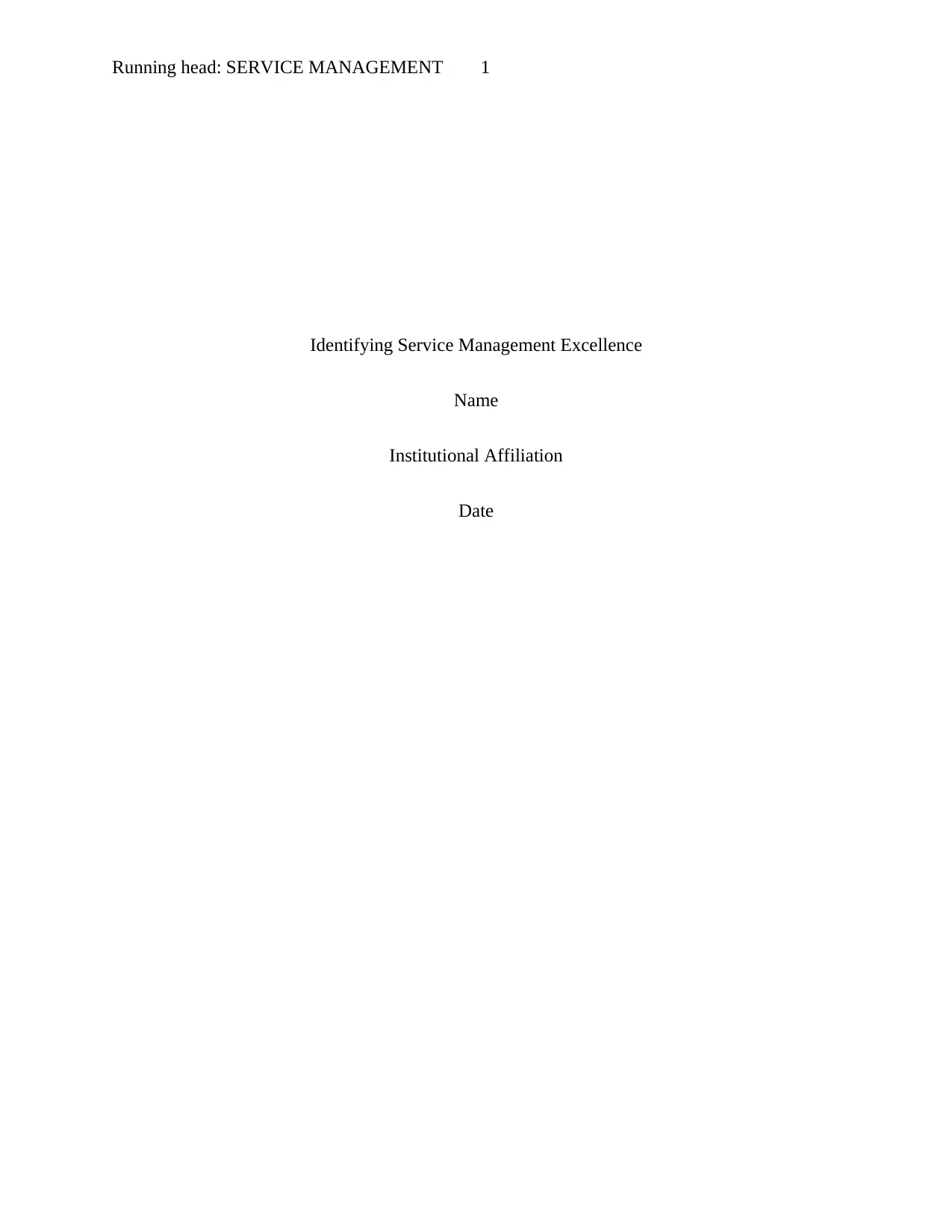
Running head: SERVICE MANAGEMENT 1
Identifying Service Management Excellence
Name
Institutional Affiliation
Date
Identifying Service Management Excellence
Name
Institutional Affiliation
Date
Paraphrase This Document
Need a fresh take? Get an instant paraphrase of this document with our AI Paraphraser
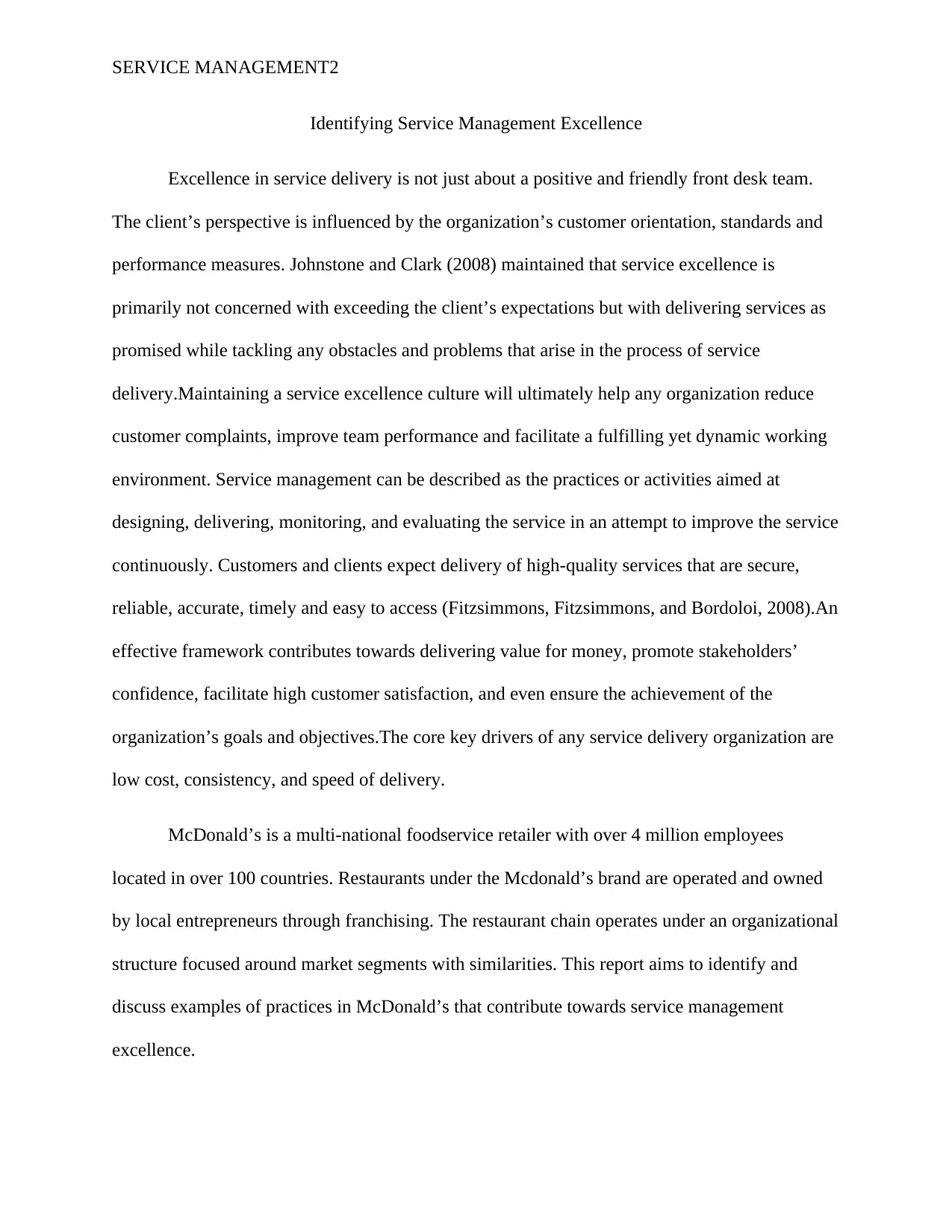
SERVICE MANAGEMENT2
Identifying Service Management Excellence
Excellence in service delivery is not just about a positive and friendly front desk team.
The client’s perspective is influenced by the organization’s customer orientation, standards and
performance measures. Johnstone and Clark (2008) maintained that service excellence is
primarily not concerned with exceeding the client’s expectations but with delivering services as
promised while tackling any obstacles and problems that arise in the process of service
delivery.Maintaining a service excellence culture will ultimately help any organization reduce
customer complaints, improve team performance and facilitate a fulfilling yet dynamic working
environment. Service management can be described as the practices or activities aimed at
designing, delivering, monitoring, and evaluating the service in an attempt to improve the service
continuously. Customers and clients expect delivery of high-quality services that are secure,
reliable, accurate, timely and easy to access (Fitzsimmons, Fitzsimmons, and Bordoloi, 2008).An
effective framework contributes towards delivering value for money, promote stakeholders’
confidence, facilitate high customer satisfaction, and even ensure the achievement of the
organization’s goals and objectives.The core key drivers of any service delivery organization are
low cost, consistency, and speed of delivery.
McDonald’s is a multi-national foodservice retailer with over 4 million employees
located in over 100 countries. Restaurants under the Mcdonald’s brand are operated and owned
by local entrepreneurs through franchising. The restaurant chain operates under an organizational
structure focused around market segments with similarities. This report aims to identify and
discuss examples of practices in McDonald’s that contribute towards service management
excellence.
Identifying Service Management Excellence
Excellence in service delivery is not just about a positive and friendly front desk team.
The client’s perspective is influenced by the organization’s customer orientation, standards and
performance measures. Johnstone and Clark (2008) maintained that service excellence is
primarily not concerned with exceeding the client’s expectations but with delivering services as
promised while tackling any obstacles and problems that arise in the process of service
delivery.Maintaining a service excellence culture will ultimately help any organization reduce
customer complaints, improve team performance and facilitate a fulfilling yet dynamic working
environment. Service management can be described as the practices or activities aimed at
designing, delivering, monitoring, and evaluating the service in an attempt to improve the service
continuously. Customers and clients expect delivery of high-quality services that are secure,
reliable, accurate, timely and easy to access (Fitzsimmons, Fitzsimmons, and Bordoloi, 2008).An
effective framework contributes towards delivering value for money, promote stakeholders’
confidence, facilitate high customer satisfaction, and even ensure the achievement of the
organization’s goals and objectives.The core key drivers of any service delivery organization are
low cost, consistency, and speed of delivery.
McDonald’s is a multi-national foodservice retailer with over 4 million employees
located in over 100 countries. Restaurants under the Mcdonald’s brand are operated and owned
by local entrepreneurs through franchising. The restaurant chain operates under an organizational
structure focused around market segments with similarities. This report aims to identify and
discuss examples of practices in McDonald’s that contribute towards service management
excellence.
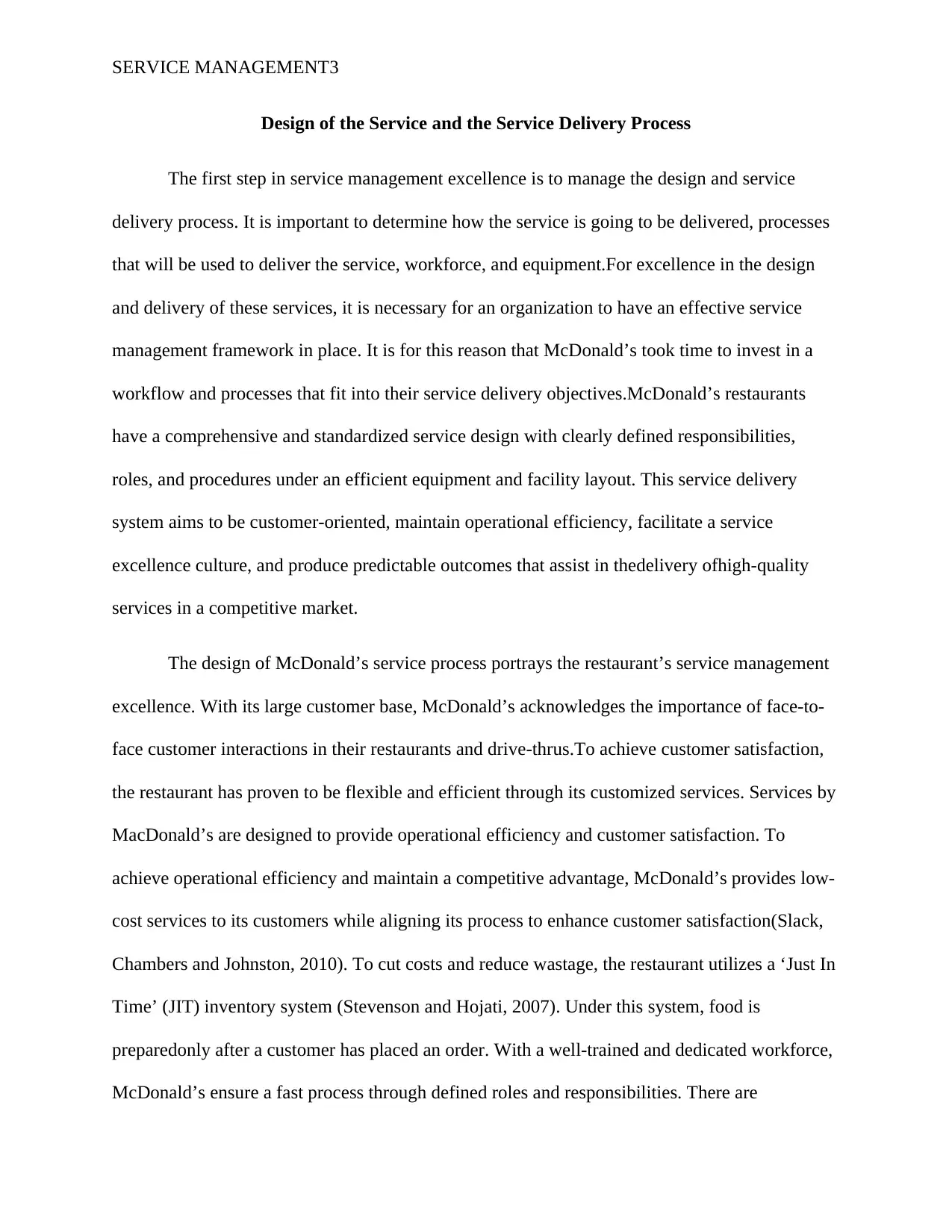
SERVICE MANAGEMENT3
Design of the Service and the Service Delivery Process
The first step in service management excellence is to manage the design and service
delivery process. It is important to determine how the service is going to be delivered, processes
that will be used to deliver the service, workforce, and equipment.For excellence in the design
and delivery of these services, it is necessary for an organization to have an effective service
management framework in place. It is for this reason that McDonald’s took time to invest in a
workflow and processes that fit into their service delivery objectives.McDonald’s restaurants
have a comprehensive and standardized service design with clearly defined responsibilities,
roles, and procedures under an efficient equipment and facility layout. This service delivery
system aims to be customer-oriented, maintain operational efficiency, facilitate a service
excellence culture, and produce predictable outcomes that assist in thedelivery ofhigh-quality
services in a competitive market.
The design of McDonald’s service process portrays the restaurant’s service management
excellence. With its large customer base, McDonald’s acknowledges the importance of face-to-
face customer interactions in their restaurants and drive-thrus.To achieve customer satisfaction,
the restaurant has proven to be flexible and efficient through its customized services. Services by
MacDonald’s are designed to provide operational efficiency and customer satisfaction. To
achieve operational efficiency and maintain a competitive advantage, McDonald’s provides low-
cost services to its customers while aligning its process to enhance customer satisfaction(Slack,
Chambers and Johnston, 2010). To cut costs and reduce wastage, the restaurant utilizes a ‘Just In
Time’ (JIT) inventory system (Stevenson and Hojati, 2007). Under this system, food is
preparedonly after a customer has placed an order. With a well-trained and dedicated workforce,
McDonald’s ensure a fast process through defined roles and responsibilities. There are
Design of the Service and the Service Delivery Process
The first step in service management excellence is to manage the design and service
delivery process. It is important to determine how the service is going to be delivered, processes
that will be used to deliver the service, workforce, and equipment.For excellence in the design
and delivery of these services, it is necessary for an organization to have an effective service
management framework in place. It is for this reason that McDonald’s took time to invest in a
workflow and processes that fit into their service delivery objectives.McDonald’s restaurants
have a comprehensive and standardized service design with clearly defined responsibilities,
roles, and procedures under an efficient equipment and facility layout. This service delivery
system aims to be customer-oriented, maintain operational efficiency, facilitate a service
excellence culture, and produce predictable outcomes that assist in thedelivery ofhigh-quality
services in a competitive market.
The design of McDonald’s service process portrays the restaurant’s service management
excellence. With its large customer base, McDonald’s acknowledges the importance of face-to-
face customer interactions in their restaurants and drive-thrus.To achieve customer satisfaction,
the restaurant has proven to be flexible and efficient through its customized services. Services by
MacDonald’s are designed to provide operational efficiency and customer satisfaction. To
achieve operational efficiency and maintain a competitive advantage, McDonald’s provides low-
cost services to its customers while aligning its process to enhance customer satisfaction(Slack,
Chambers and Johnston, 2010). To cut costs and reduce wastage, the restaurant utilizes a ‘Just In
Time’ (JIT) inventory system (Stevenson and Hojati, 2007). Under this system, food is
preparedonly after a customer has placed an order. With a well-trained and dedicated workforce,
McDonald’s ensure a fast process through defined roles and responsibilities. There are
⊘ This is a preview!⊘
Do you want full access?
Subscribe today to unlock all pages.

Trusted by 1+ million students worldwide
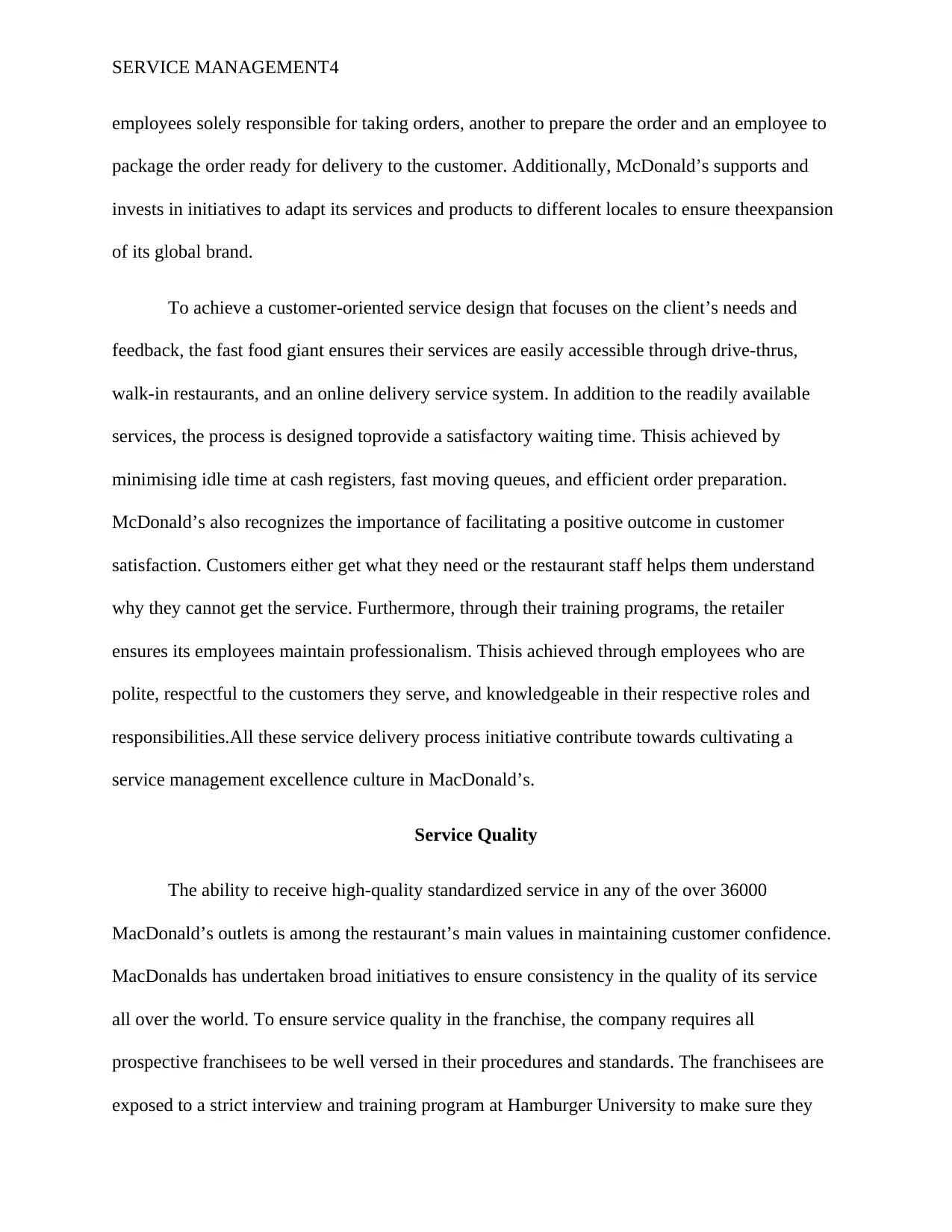
SERVICE MANAGEMENT4
employees solely responsible for taking orders, another to prepare the order and an employee to
package the order ready for delivery to the customer. Additionally, McDonald’s supports and
invests in initiatives to adapt its services and products to different locales to ensure theexpansion
of its global brand.
To achieve a customer-oriented service design that focuses on the client’s needs and
feedback, the fast food giant ensures their services are easily accessible through drive-thrus,
walk-in restaurants, and an online delivery service system. In addition to the readily available
services, the process is designed toprovide a satisfactory waiting time. Thisis achieved by
minimising idle time at cash registers, fast moving queues, and efficient order preparation.
McDonald’s also recognizes the importance of facilitating a positive outcome in customer
satisfaction. Customers either get what they need or the restaurant staff helps them understand
why they cannot get the service. Furthermore, through their training programs, the retailer
ensures its employees maintain professionalism. Thisis achieved through employees who are
polite, respectful to the customers they serve, and knowledgeable in their respective roles and
responsibilities.All these service delivery process initiative contribute towards cultivating a
service management excellence culture in MacDonald’s.
Service Quality
The ability to receive high-quality standardized service in any of the over 36000
MacDonald’s outlets is among the restaurant’s main values in maintaining customer confidence.
MacDonalds has undertaken broad initiatives to ensure consistency in the quality of its service
all over the world. To ensure service quality in the franchise, the company requires all
prospective franchisees to be well versed in their procedures and standards. The franchisees are
exposed to a strict interview and training program at Hamburger University to make sure they
employees solely responsible for taking orders, another to prepare the order and an employee to
package the order ready for delivery to the customer. Additionally, McDonald’s supports and
invests in initiatives to adapt its services and products to different locales to ensure theexpansion
of its global brand.
To achieve a customer-oriented service design that focuses on the client’s needs and
feedback, the fast food giant ensures their services are easily accessible through drive-thrus,
walk-in restaurants, and an online delivery service system. In addition to the readily available
services, the process is designed toprovide a satisfactory waiting time. Thisis achieved by
minimising idle time at cash registers, fast moving queues, and efficient order preparation.
McDonald’s also recognizes the importance of facilitating a positive outcome in customer
satisfaction. Customers either get what they need or the restaurant staff helps them understand
why they cannot get the service. Furthermore, through their training programs, the retailer
ensures its employees maintain professionalism. Thisis achieved through employees who are
polite, respectful to the customers they serve, and knowledgeable in their respective roles and
responsibilities.All these service delivery process initiative contribute towards cultivating a
service management excellence culture in MacDonald’s.
Service Quality
The ability to receive high-quality standardized service in any of the over 36000
MacDonald’s outlets is among the restaurant’s main values in maintaining customer confidence.
MacDonalds has undertaken broad initiatives to ensure consistency in the quality of its service
all over the world. To ensure service quality in the franchise, the company requires all
prospective franchisees to be well versed in their procedures and standards. The franchisees are
exposed to a strict interview and training program at Hamburger University to make sure they
Paraphrase This Document
Need a fresh take? Get an instant paraphrase of this document with our AI Paraphraser
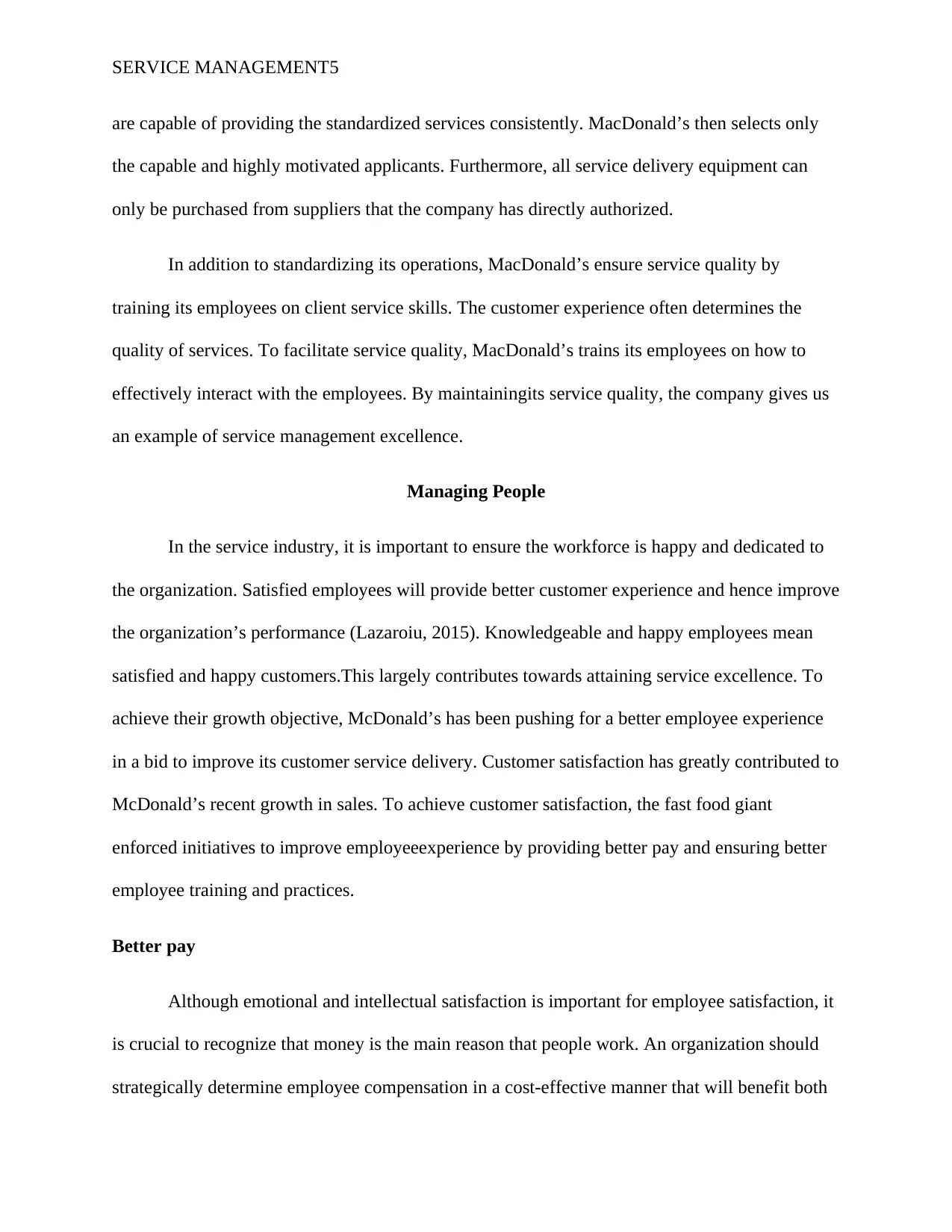
SERVICE MANAGEMENT5
are capable of providing the standardized services consistently. MacDonald’s then selects only
the capable and highly motivated applicants. Furthermore, all service delivery equipment can
only be purchased from suppliers that the company has directly authorized.
In addition to standardizing its operations, MacDonald’s ensure service quality by
training its employees on client service skills. The customer experience often determines the
quality of services. To facilitate service quality, MacDonald’s trains its employees on how to
effectively interact with the employees. By maintainingits service quality, the company gives us
an example of service management excellence.
Managing People
In the service industry, it is important to ensure the workforce is happy and dedicated to
the organization. Satisfied employees will provide better customer experience and hence improve
the organization’s performance (Lazaroiu, 2015). Knowledgeable and happy employees mean
satisfied and happy customers.This largely contributes towards attaining service excellence. To
achieve their growth objective, McDonald’s has been pushing for a better employee experience
in a bid to improve its customer service delivery. Customer satisfaction has greatly contributed to
McDonald’s recent growth in sales. To achieve customer satisfaction, the fast food giant
enforced initiatives to improve employeeexperience by providing better pay and ensuring better
employee training and practices.
Better pay
Although emotional and intellectual satisfaction is important for employee satisfaction, it
is crucial to recognize that money is the main reason that people work. An organization should
strategically determine employee compensation in a cost-effective manner that will benefit both
are capable of providing the standardized services consistently. MacDonald’s then selects only
the capable and highly motivated applicants. Furthermore, all service delivery equipment can
only be purchased from suppliers that the company has directly authorized.
In addition to standardizing its operations, MacDonald’s ensure service quality by
training its employees on client service skills. The customer experience often determines the
quality of services. To facilitate service quality, MacDonald’s trains its employees on how to
effectively interact with the employees. By maintainingits service quality, the company gives us
an example of service management excellence.
Managing People
In the service industry, it is important to ensure the workforce is happy and dedicated to
the organization. Satisfied employees will provide better customer experience and hence improve
the organization’s performance (Lazaroiu, 2015). Knowledgeable and happy employees mean
satisfied and happy customers.This largely contributes towards attaining service excellence. To
achieve their growth objective, McDonald’s has been pushing for a better employee experience
in a bid to improve its customer service delivery. Customer satisfaction has greatly contributed to
McDonald’s recent growth in sales. To achieve customer satisfaction, the fast food giant
enforced initiatives to improve employeeexperience by providing better pay and ensuring better
employee training and practices.
Better pay
Although emotional and intellectual satisfaction is important for employee satisfaction, it
is crucial to recognize that money is the main reason that people work. An organization should
strategically determine employee compensation in a cost-effective manner that will benefit both
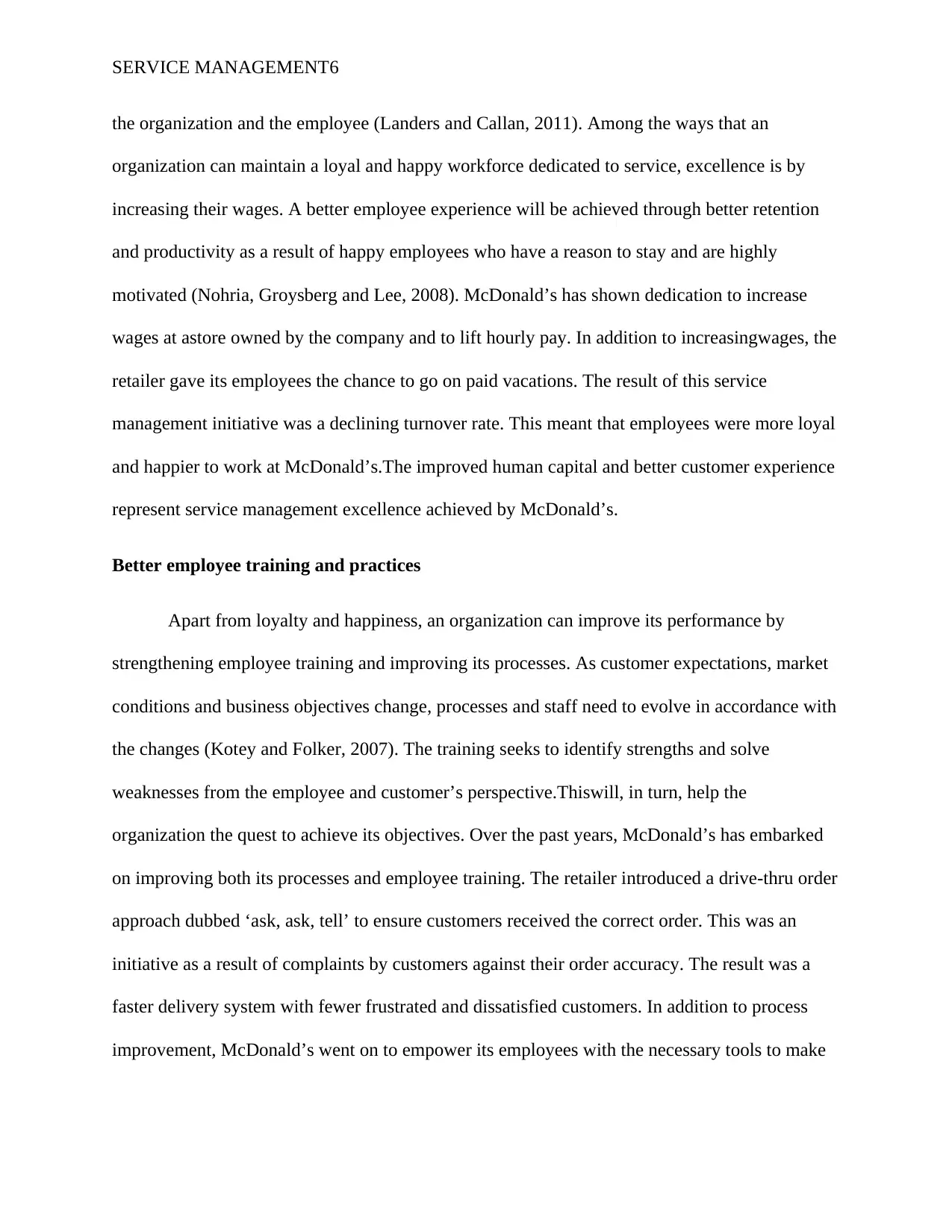
SERVICE MANAGEMENT6
the organization and the employee (Landers and Callan, 2011). Among the ways that an
organization can maintain a loyal and happy workforce dedicated to service, excellence is by
increasing their wages. A better employee experience will be achieved through better retention
and productivity as a result of happy employees who have a reason to stay and are highly
motivated (Nohria, Groysberg and Lee, 2008). McDonald’s has shown dedication to increase
wages at astore owned by the company and to lift hourly pay. In addition to increasingwages, the
retailer gave its employees the chance to go on paid vacations. The result of this service
management initiative was a declining turnover rate. This meant that employees were more loyal
and happier to work at McDonald’s.The improved human capital and better customer experience
represent service management excellence achieved by McDonald’s.
Better employee training and practices
Apart from loyalty and happiness, an organization can improve its performance by
strengthening employee training and improving its processes. As customer expectations, market
conditions and business objectives change, processes and staff need to evolve in accordance with
the changes (Kotey and Folker, 2007). The training seeks to identify strengths and solve
weaknesses from the employee and customer’s perspective.Thiswill, in turn, help the
organization the quest to achieve its objectives. Over the past years, McDonald’s has embarked
on improving both its processes and employee training. The retailer introduced a drive-thru order
approach dubbed ‘ask, ask, tell’ to ensure customers received the correct order. This was an
initiative as a result of complaints by customers against their order accuracy. The result was a
faster delivery system with fewer frustrated and dissatisfied customers. In addition to process
improvement, McDonald’s went on to empower its employees with the necessary tools to make
the organization and the employee (Landers and Callan, 2011). Among the ways that an
organization can maintain a loyal and happy workforce dedicated to service, excellence is by
increasing their wages. A better employee experience will be achieved through better retention
and productivity as a result of happy employees who have a reason to stay and are highly
motivated (Nohria, Groysberg and Lee, 2008). McDonald’s has shown dedication to increase
wages at astore owned by the company and to lift hourly pay. In addition to increasingwages, the
retailer gave its employees the chance to go on paid vacations. The result of this service
management initiative was a declining turnover rate. This meant that employees were more loyal
and happier to work at McDonald’s.The improved human capital and better customer experience
represent service management excellence achieved by McDonald’s.
Better employee training and practices
Apart from loyalty and happiness, an organization can improve its performance by
strengthening employee training and improving its processes. As customer expectations, market
conditions and business objectives change, processes and staff need to evolve in accordance with
the changes (Kotey and Folker, 2007). The training seeks to identify strengths and solve
weaknesses from the employee and customer’s perspective.Thiswill, in turn, help the
organization the quest to achieve its objectives. Over the past years, McDonald’s has embarked
on improving both its processes and employee training. The retailer introduced a drive-thru order
approach dubbed ‘ask, ask, tell’ to ensure customers received the correct order. This was an
initiative as a result of complaints by customers against their order accuracy. The result was a
faster delivery system with fewer frustrated and dissatisfied customers. In addition to process
improvement, McDonald’s went on to empower its employees with the necessary tools to make
⊘ This is a preview!⊘
Do you want full access?
Subscribe today to unlock all pages.

Trusted by 1+ million students worldwide
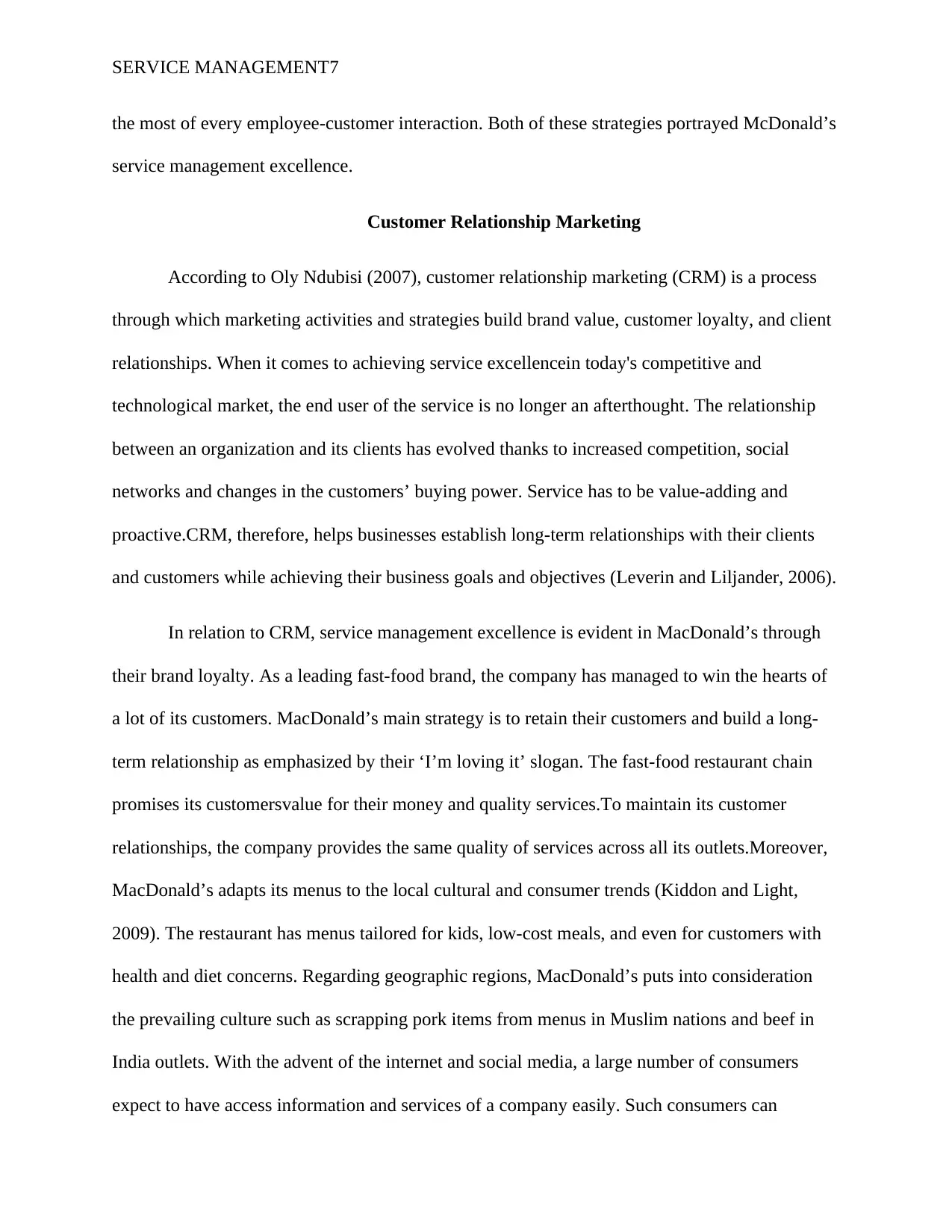
SERVICE MANAGEMENT7
the most of every employee-customer interaction. Both of these strategies portrayed McDonald’s
service management excellence.
Customer Relationship Marketing
According to Oly Ndubisi (2007), customer relationship marketing (CRM) is a process
through which marketing activities and strategies build brand value, customer loyalty, and client
relationships. When it comes to achieving service excellencein today's competitive and
technological market, the end user of the service is no longer an afterthought. The relationship
between an organization and its clients has evolved thanks to increased competition, social
networks and changes in the customers’ buying power. Service has to be value-adding and
proactive.CRM, therefore, helps businesses establish long-term relationships with their clients
and customers while achieving their business goals and objectives (Leverin and Liljander, 2006).
In relation to CRM, service management excellence is evident in MacDonald’s through
their brand loyalty. As a leading fast-food brand, the company has managed to win the hearts of
a lot of its customers. MacDonald’s main strategy is to retain their customers and build a long-
term relationship as emphasized by their ‘I’m loving it’ slogan. The fast-food restaurant chain
promises its customersvalue for their money and quality services.To maintain its customer
relationships, the company provides the same quality of services across all its outlets.Moreover,
MacDonald’s adapts its menus to the local cultural and consumer trends (Kiddon and Light,
2009). The restaurant has menus tailored for kids, low-cost meals, and even for customers with
health and diet concerns. Regarding geographic regions, MacDonald’s puts into consideration
the prevailing culture such as scrapping pork items from menus in Muslim nations and beef in
India outlets. With the advent of the internet and social media, a large number of consumers
expect to have access information and services of a company easily. Such consumers can
the most of every employee-customer interaction. Both of these strategies portrayed McDonald’s
service management excellence.
Customer Relationship Marketing
According to Oly Ndubisi (2007), customer relationship marketing (CRM) is a process
through which marketing activities and strategies build brand value, customer loyalty, and client
relationships. When it comes to achieving service excellencein today's competitive and
technological market, the end user of the service is no longer an afterthought. The relationship
between an organization and its clients has evolved thanks to increased competition, social
networks and changes in the customers’ buying power. Service has to be value-adding and
proactive.CRM, therefore, helps businesses establish long-term relationships with their clients
and customers while achieving their business goals and objectives (Leverin and Liljander, 2006).
In relation to CRM, service management excellence is evident in MacDonald’s through
their brand loyalty. As a leading fast-food brand, the company has managed to win the hearts of
a lot of its customers. MacDonald’s main strategy is to retain their customers and build a long-
term relationship as emphasized by their ‘I’m loving it’ slogan. The fast-food restaurant chain
promises its customersvalue for their money and quality services.To maintain its customer
relationships, the company provides the same quality of services across all its outlets.Moreover,
MacDonald’s adapts its menus to the local cultural and consumer trends (Kiddon and Light,
2009). The restaurant has menus tailored for kids, low-cost meals, and even for customers with
health and diet concerns. Regarding geographic regions, MacDonald’s puts into consideration
the prevailing culture such as scrapping pork items from menus in Muslim nations and beef in
India outlets. With the advent of the internet and social media, a large number of consumers
expect to have access information and services of a company easily. Such consumers can
Paraphrase This Document
Need a fresh take? Get an instant paraphrase of this document with our AI Paraphraser
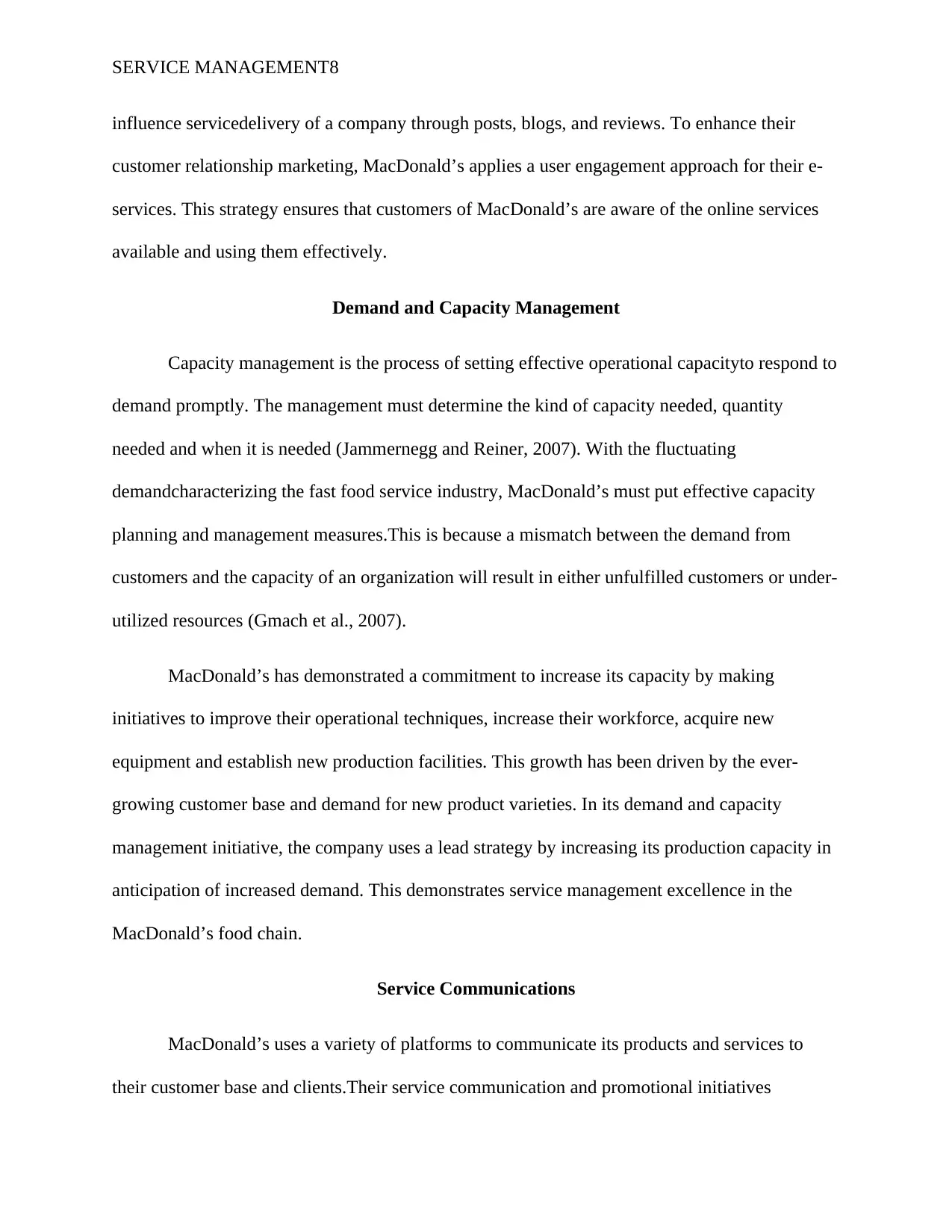
SERVICE MANAGEMENT8
influence servicedelivery of a company through posts, blogs, and reviews. To enhance their
customer relationship marketing, MacDonald’s applies a user engagement approach for their e-
services. This strategy ensures that customers of MacDonald’s are aware of the online services
available and using them effectively.
Demand and Capacity Management
Capacity management is the process of setting effective operational capacityto respond to
demand promptly. The management must determine the kind of capacity needed, quantity
needed and when it is needed (Jammernegg and Reiner, 2007). With the fluctuating
demandcharacterizing the fast food service industry, MacDonald’s must put effective capacity
planning and management measures.This is because a mismatch between the demand from
customers and the capacity of an organization will result in either unfulfilled customers or under-
utilized resources (Gmach et al., 2007).
MacDonald’s has demonstrated a commitment to increase its capacity by making
initiatives to improve their operational techniques, increase their workforce, acquire new
equipment and establish new production facilities. This growth has been driven by the ever-
growing customer base and demand for new product varieties. In its demand and capacity
management initiative, the company uses a lead strategy by increasing its production capacity in
anticipation of increased demand. This demonstrates service management excellence in the
MacDonald’s food chain.
Service Communications
MacDonald’s uses a variety of platforms to communicate its products and services to
their customer base and clients.Their service communication and promotional initiatives
influence servicedelivery of a company through posts, blogs, and reviews. To enhance their
customer relationship marketing, MacDonald’s applies a user engagement approach for their e-
services. This strategy ensures that customers of MacDonald’s are aware of the online services
available and using them effectively.
Demand and Capacity Management
Capacity management is the process of setting effective operational capacityto respond to
demand promptly. The management must determine the kind of capacity needed, quantity
needed and when it is needed (Jammernegg and Reiner, 2007). With the fluctuating
demandcharacterizing the fast food service industry, MacDonald’s must put effective capacity
planning and management measures.This is because a mismatch between the demand from
customers and the capacity of an organization will result in either unfulfilled customers or under-
utilized resources (Gmach et al., 2007).
MacDonald’s has demonstrated a commitment to increase its capacity by making
initiatives to improve their operational techniques, increase their workforce, acquire new
equipment and establish new production facilities. This growth has been driven by the ever-
growing customer base and demand for new product varieties. In its demand and capacity
management initiative, the company uses a lead strategy by increasing its production capacity in
anticipation of increased demand. This demonstrates service management excellence in the
MacDonald’s food chain.
Service Communications
MacDonald’s uses a variety of platforms to communicate its products and services to
their customer base and clients.Their service communication and promotional initiatives
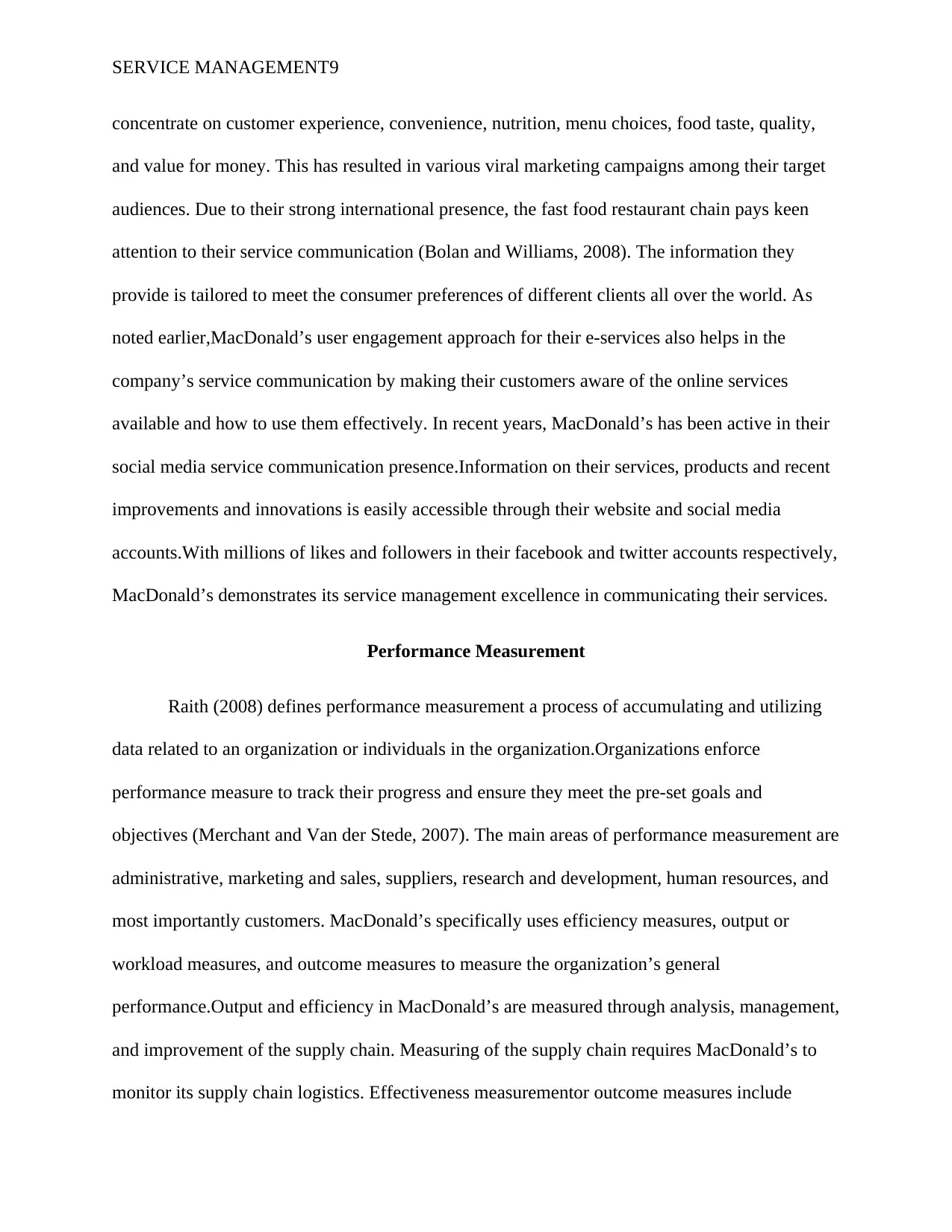
SERVICE MANAGEMENT9
concentrate on customer experience, convenience, nutrition, menu choices, food taste, quality,
and value for money. This has resulted in various viral marketing campaigns among their target
audiences. Due to their strong international presence, the fast food restaurant chain pays keen
attention to their service communication (Bolan and Williams, 2008). The information they
provide is tailored to meet the consumer preferences of different clients all over the world. As
noted earlier,MacDonald’s user engagement approach for their e-services also helps in the
company’s service communication by making their customers aware of the online services
available and how to use them effectively. In recent years, MacDonald’s has been active in their
social media service communication presence.Information on their services, products and recent
improvements and innovations is easily accessible through their website and social media
accounts.With millions of likes and followers in their facebook and twitter accounts respectively,
MacDonald’s demonstrates its service management excellence in communicating their services.
Performance Measurement
Raith (2008) defines performance measurement a process of accumulating and utilizing
data related to an organization or individuals in the organization.Organizations enforce
performance measure to track their progress and ensure they meet the pre-set goals and
objectives (Merchant and Van der Stede, 2007). The main areas of performance measurement are
administrative, marketing and sales, suppliers, research and development, human resources, and
most importantly customers. MacDonald’s specifically uses efficiency measures, output or
workload measures, and outcome measures to measure the organization’s general
performance.Output and efficiency in MacDonald’s are measured through analysis, management,
and improvement of the supply chain. Measuring of the supply chain requires MacDonald’s to
monitor its supply chain logistics. Effectiveness measurementor outcome measures include
concentrate on customer experience, convenience, nutrition, menu choices, food taste, quality,
and value for money. This has resulted in various viral marketing campaigns among their target
audiences. Due to their strong international presence, the fast food restaurant chain pays keen
attention to their service communication (Bolan and Williams, 2008). The information they
provide is tailored to meet the consumer preferences of different clients all over the world. As
noted earlier,MacDonald’s user engagement approach for their e-services also helps in the
company’s service communication by making their customers aware of the online services
available and how to use them effectively. In recent years, MacDonald’s has been active in their
social media service communication presence.Information on their services, products and recent
improvements and innovations is easily accessible through their website and social media
accounts.With millions of likes and followers in their facebook and twitter accounts respectively,
MacDonald’s demonstrates its service management excellence in communicating their services.
Performance Measurement
Raith (2008) defines performance measurement a process of accumulating and utilizing
data related to an organization or individuals in the organization.Organizations enforce
performance measure to track their progress and ensure they meet the pre-set goals and
objectives (Merchant and Van der Stede, 2007). The main areas of performance measurement are
administrative, marketing and sales, suppliers, research and development, human resources, and
most importantly customers. MacDonald’s specifically uses efficiency measures, output or
workload measures, and outcome measures to measure the organization’s general
performance.Output and efficiency in MacDonald’s are measured through analysis, management,
and improvement of the supply chain. Measuring of the supply chain requires MacDonald’s to
monitor its supply chain logistics. Effectiveness measurementor outcome measures include
⊘ This is a preview!⊘
Do you want full access?
Subscribe today to unlock all pages.

Trusted by 1+ million students worldwide
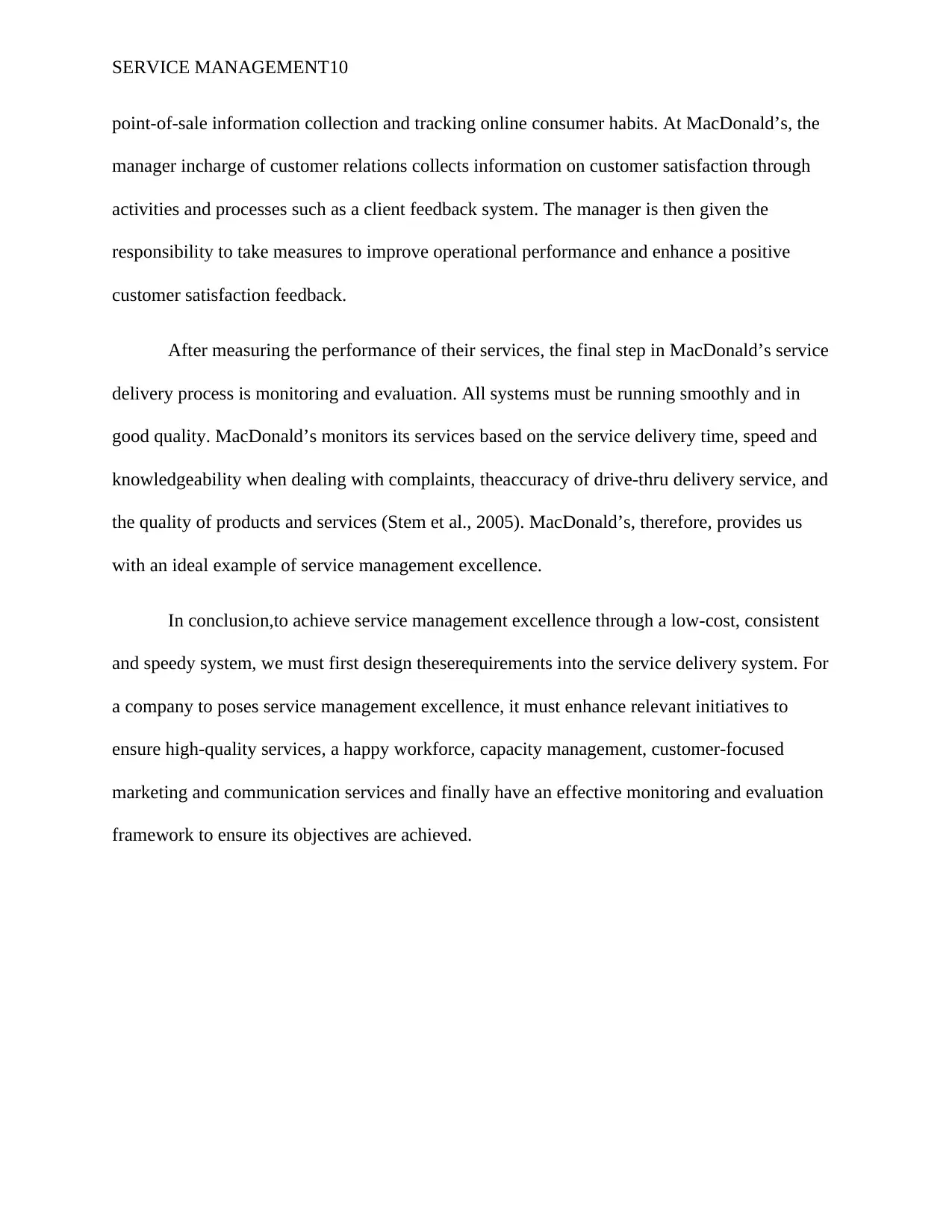
SERVICE MANAGEMENT10
point-of-sale information collection and tracking online consumer habits. At MacDonald’s, the
manager incharge of customer relations collects information on customer satisfaction through
activities and processes such as a client feedback system. The manager is then given the
responsibility to take measures to improve operational performance and enhance a positive
customer satisfaction feedback.
After measuring the performance of their services, the final step in MacDonald’s service
delivery process is monitoring and evaluation. All systems must be running smoothly and in
good quality. MacDonald’s monitors its services based on the service delivery time, speed and
knowledgeability when dealing with complaints, theaccuracy of drive-thru delivery service, and
the quality of products and services (Stem et al., 2005). MacDonald’s, therefore, provides us
with an ideal example of service management excellence.
In conclusion,to achieve service management excellence through a low-cost, consistent
and speedy system, we must first design theserequirements into the service delivery system. For
a company to poses service management excellence, it must enhance relevant initiatives to
ensure high-quality services, a happy workforce, capacity management, customer-focused
marketing and communication services and finally have an effective monitoring and evaluation
framework to ensure its objectives are achieved.
point-of-sale information collection and tracking online consumer habits. At MacDonald’s, the
manager incharge of customer relations collects information on customer satisfaction through
activities and processes such as a client feedback system. The manager is then given the
responsibility to take measures to improve operational performance and enhance a positive
customer satisfaction feedback.
After measuring the performance of their services, the final step in MacDonald’s service
delivery process is monitoring and evaluation. All systems must be running smoothly and in
good quality. MacDonald’s monitors its services based on the service delivery time, speed and
knowledgeability when dealing with complaints, theaccuracy of drive-thru delivery service, and
the quality of products and services (Stem et al., 2005). MacDonald’s, therefore, provides us
with an ideal example of service management excellence.
In conclusion,to achieve service management excellence through a low-cost, consistent
and speedy system, we must first design theserequirements into the service delivery system. For
a company to poses service management excellence, it must enhance relevant initiatives to
ensure high-quality services, a happy workforce, capacity management, customer-focused
marketing and communication services and finally have an effective monitoring and evaluation
framework to ensure its objectives are achieved.
Paraphrase This Document
Need a fresh take? Get an instant paraphrase of this document with our AI Paraphraser
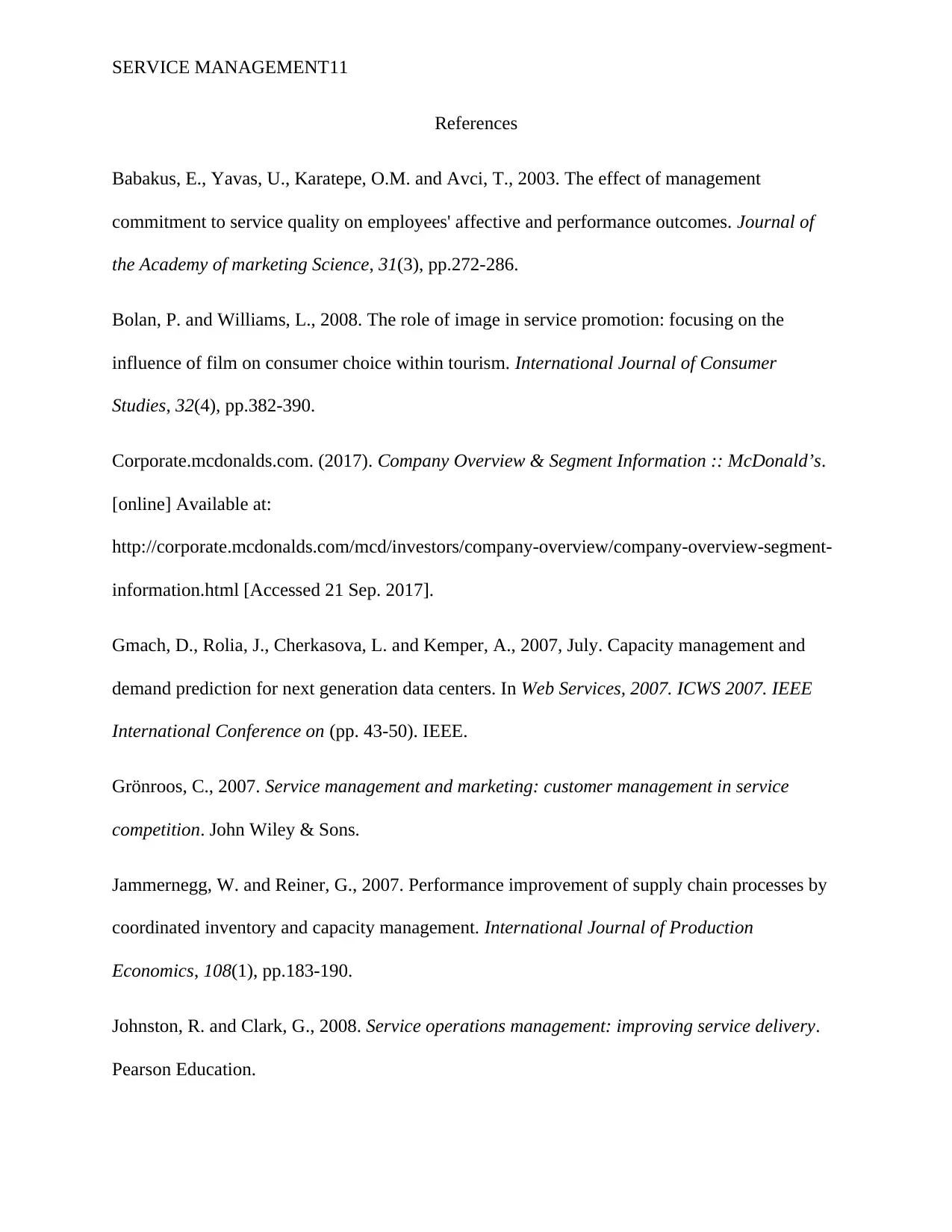
SERVICE MANAGEMENT11
References
Babakus, E., Yavas, U., Karatepe, O.M. and Avci, T., 2003. The effect of management
commitment to service quality on employees' affective and performance outcomes. Journal of
the Academy of marketing Science, 31(3), pp.272-286.
Bolan, P. and Williams, L., 2008. The role of image in service promotion: focusing on the
influence of film on consumer choice within tourism. International Journal of Consumer
Studies, 32(4), pp.382-390.
Corporate.mcdonalds.com. (2017). Company Overview & Segment Information :: McDonald’s.
[online] Available at:
http://corporate.mcdonalds.com/mcd/investors/company-overview/company-overview-segment-
information.html [Accessed 21 Sep. 2017].
Gmach, D., Rolia, J., Cherkasova, L. and Kemper, A., 2007, July. Capacity management and
demand prediction for next generation data centers. In Web Services, 2007. ICWS 2007. IEEE
International Conference on (pp. 43-50). IEEE.
Grönroos, C., 2007. Service management and marketing: customer management in service
competition. John Wiley & Sons.
Jammernegg, W. and Reiner, G., 2007. Performance improvement of supply chain processes by
coordinated inventory and capacity management. International Journal of Production
Economics, 108(1), pp.183-190.
Johnston, R. and Clark, G., 2008. Service operations management: improving service delivery.
Pearson Education.
References
Babakus, E., Yavas, U., Karatepe, O.M. and Avci, T., 2003. The effect of management
commitment to service quality on employees' affective and performance outcomes. Journal of
the Academy of marketing Science, 31(3), pp.272-286.
Bolan, P. and Williams, L., 2008. The role of image in service promotion: focusing on the
influence of film on consumer choice within tourism. International Journal of Consumer
Studies, 32(4), pp.382-390.
Corporate.mcdonalds.com. (2017). Company Overview & Segment Information :: McDonald’s.
[online] Available at:
http://corporate.mcdonalds.com/mcd/investors/company-overview/company-overview-segment-
information.html [Accessed 21 Sep. 2017].
Gmach, D., Rolia, J., Cherkasova, L. and Kemper, A., 2007, July. Capacity management and
demand prediction for next generation data centers. In Web Services, 2007. ICWS 2007. IEEE
International Conference on (pp. 43-50). IEEE.
Grönroos, C., 2007. Service management and marketing: customer management in service
competition. John Wiley & Sons.
Jammernegg, W. and Reiner, G., 2007. Performance improvement of supply chain processes by
coordinated inventory and capacity management. International Journal of Production
Economics, 108(1), pp.183-190.
Johnston, R. and Clark, G., 2008. Service operations management: improving service delivery.
Pearson Education.
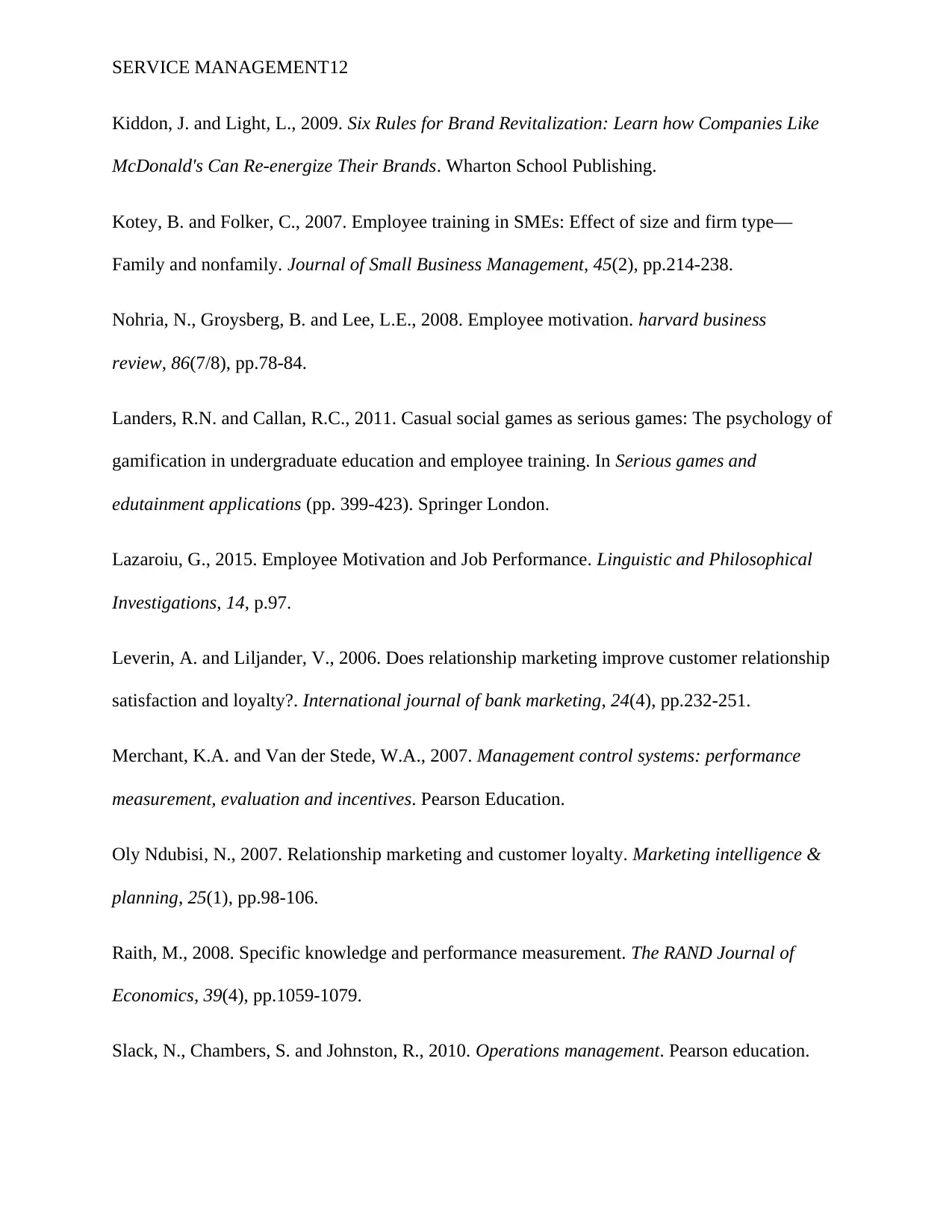
SERVICE MANAGEMENT12
Kiddon, J. and Light, L., 2009. Six Rules for Brand Revitalization: Learn how Companies Like
McDonald's Can Re-energize Their Brands. Wharton School Publishing.
Kotey, B. and Folker, C., 2007. Employee training in SMEs: Effect of size and firm type—
Family and nonfamily. Journal of Small Business Management, 45(2), pp.214-238.
Nohria, N., Groysberg, B. and Lee, L.E., 2008. Employee motivation. harvard business
review, 86(7/8), pp.78-84.
Landers, R.N. and Callan, R.C., 2011. Casual social games as serious games: The psychology of
gamification in undergraduate education and employee training. In Serious games and
edutainment applications (pp. 399-423). Springer London.
Lazaroiu, G., 2015. Employee Motivation and Job Performance. Linguistic and Philosophical
Investigations, 14, p.97.
Leverin, A. and Liljander, V., 2006. Does relationship marketing improve customer relationship
satisfaction and loyalty?. International journal of bank marketing, 24(4), pp.232-251.
Merchant, K.A. and Van der Stede, W.A., 2007. Management control systems: performance
measurement, evaluation and incentives. Pearson Education.
Oly Ndubisi, N., 2007. Relationship marketing and customer loyalty. Marketing intelligence &
planning, 25(1), pp.98-106.
Raith, M., 2008. Specific knowledge and performance measurement. The RAND Journal of
Economics, 39(4), pp.1059-1079.
Slack, N., Chambers, S. and Johnston, R., 2010. Operations management. Pearson education.
Kiddon, J. and Light, L., 2009. Six Rules for Brand Revitalization: Learn how Companies Like
McDonald's Can Re-energize Their Brands. Wharton School Publishing.
Kotey, B. and Folker, C., 2007. Employee training in SMEs: Effect of size and firm type—
Family and nonfamily. Journal of Small Business Management, 45(2), pp.214-238.
Nohria, N., Groysberg, B. and Lee, L.E., 2008. Employee motivation. harvard business
review, 86(7/8), pp.78-84.
Landers, R.N. and Callan, R.C., 2011. Casual social games as serious games: The psychology of
gamification in undergraduate education and employee training. In Serious games and
edutainment applications (pp. 399-423). Springer London.
Lazaroiu, G., 2015. Employee Motivation and Job Performance. Linguistic and Philosophical
Investigations, 14, p.97.
Leverin, A. and Liljander, V., 2006. Does relationship marketing improve customer relationship
satisfaction and loyalty?. International journal of bank marketing, 24(4), pp.232-251.
Merchant, K.A. and Van der Stede, W.A., 2007. Management control systems: performance
measurement, evaluation and incentives. Pearson Education.
Oly Ndubisi, N., 2007. Relationship marketing and customer loyalty. Marketing intelligence &
planning, 25(1), pp.98-106.
Raith, M., 2008. Specific knowledge and performance measurement. The RAND Journal of
Economics, 39(4), pp.1059-1079.
Slack, N., Chambers, S. and Johnston, R., 2010. Operations management. Pearson education.
⊘ This is a preview!⊘
Do you want full access?
Subscribe today to unlock all pages.

Trusted by 1+ million students worldwide
1 out of 13
Related Documents
Your All-in-One AI-Powered Toolkit for Academic Success.
+13062052269
info@desklib.com
Available 24*7 on WhatsApp / Email
![[object Object]](/_next/static/media/star-bottom.7253800d.svg)
Unlock your academic potential
Copyright © 2020–2025 A2Z Services. All Rights Reserved. Developed and managed by ZUCOL.





